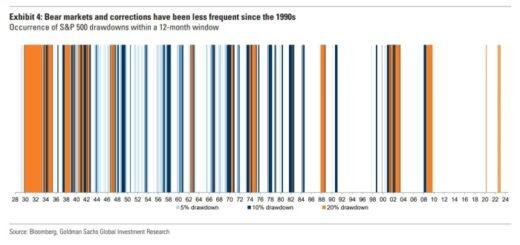The Treasurys’ Role: Will They Spark a U.S. Stock Market Surge Before Year-End?
Thierry Wizman of Macquarie suggests that the Federal Reserve will continue to maintain its “higher-for-longer” interest rate stance until it detects weaknesses in the consumer side of the market. The recent turbulence in the world’s largest bond market has placed significant pressure on U.S. stocks, as investors come to terms with the idea that high interest rates may persist well into 2024, pending a reduction in underlying inflationary pressures.
The U.S. Treasury market, a cornerstone of the global financial system, has weathered a series of sell-offs since late September, pushing yields on 10-year and 30-year Treasurys to levels not seen since the lead-up to the 2008 financial crisis before experiencing a recent decline.
In September, a bond market sell-off was triggered by the Federal Reserve’s hawkish outlook, along with concerns about the U.S. fiscal deficit, federal debt, and the potential for a government shutdown if the 2024 fiscal year budget remains unresolved by mid-November.
However, this week, increased uncertainty related to the Middle East conflict led to heightened demand for safer assets, resulting in an increase in long-term bond prices and a decrease in yields. On Thursday, a Treasury bond auction saw reduced demand, despite notably higher yields, leading to another increase in longer-term rates. Concurrently, investors were confronted with inflation data showing elevated consumer prices in September, contributing to a drop in U.S. stocks.
Investors are now questioning the conditions required for interest rates and bond yields to decrease in the coming months, potentially boosting stock markets as they approach year-end.
Tim Hayes, the Chief Global Investment Strategist at Ned Davis Research, suggests that excessive pessimism in the bond market could set the stage for a relief rally in both stocks and bonds. According to Hayes, there may be less inflationary pressure than the market has anticipated, and a change in sentiment in the Treasury market may drive bond yields lower, benefiting equities.
However, some analysts argue that disinflation might not be sufficient to prompt the Federal Reserve to abandon its “higher-for-longer” interest rate narrative, which has been a major driver of the surge in yields since September. Thierry Wizman of Macquarie believes that a slowdown in the consumer sector is necessary to alter the Fed’s stance and encourage a more flexible long-term outlook among policymakers.
While the Fed is not currently signaling a removal of the “higher-for-longer” narrative, Wizman is confident that U.S. consumption data will weaken in the coming months, potentially due to consumer-product and -service companies providing guidance for the fourth quarter and consumers adjusting their spending for the holiday shopping season.
While a consumer-side slowdown could benefit bonds, investors should remain cautious about buying into the stock market, as stock valuations could still appear elevated with Treasury yields at 16-year highs.
The “higher-for-longer” narrative has been used by Fed officials to indicate the potential for sustained higher interest rates. However, Wizman sees it as a “publicity stunt” designed to tighten financial conditions in the short term.
If consumer sector slowdown and ongoing disinflation can temper the Fed’s rate expectations, Treasury yields may continue to decline without requiring a major economic downturn. Additionally, the historical seasonality of the stock market suggests the possibility of a rally, as the fourth quarter has historically been strong for the U.S. stock market.
The S&P 500, Dow Jones Industrial Average, and Nasdaq Composite have shown positive movements in the fourth quarter, contributing to the growing sentiment that bond yields may have reached their peak and equities could rally towards the end of the year. Yields on 10-year and 30-year Treasurys have experienced recent declines, with the 30-year yield posting its largest weekly drop in a while.




